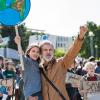
Over the next three years, more than 120 scientists will be working on a new comprehensive climate report for Austria. IIASA is taking a leading role in the activities with IIASA researchers Keywan Riahi and Daniel Huppmann serving as co-chairs of the Austrian Panel on Climate Change.
The effects of climate change are tangible across all sectors of society, including agriculture and forestry, healthcare, mobility, tourism, and ecosystem services and the Alpine region continues to suffer massively from the consequences of global warming.
Following the procedures established by the Intergovernmental Panel on Climate Change (IPCC), the first comprehensive Austrian Assessment Report on Climate Change 2014 (AAR14) led to the creation of the Austrian Panel on Climate Change (APCC) within the framework of the Austrian Climate Change Centre (CCCA). Since then, renowned researchers of the Austrian climate community regularly gather the latest scientific evidence on climate change in Austria. Work has already begun on the second Assessment Report on Climate Change in Austria (AAR2), which will provide a scientific survey and assessment of the previous, current, and potential future effects of climate change in the country, focusing on national and regional conditions alike.
"The consequences of the climate crisis are reaching almost every corner of our lives. Hot spells impact our health and extreme weather events cause huge economic damage and great suffering for the people affected. With this assessment report, we obtain a sound analysis of future consequences to take the right steps on our path towards adaptation," says Austrian Federal Minister for Climate Action, Leonore Gewessler.
According to Margreth Keiler from the Department of Geography at the University of Innsbruck, a project leader for the AAR2 as APCC co-chair, very few countries produce their own climate reports, so with this national analysis, Austria plays a pioneering role. The report’s overarching goal is an Austria-specific synthesis between scientific evidence and national and international data. However, it will also be vital to define knowledge gaps. Looking beyond the report, she expects a boosting effect for climate research in Austria.
One of the main concerns of the multidisciplinary team of experts is pointing out courses of action. In this regard, a substantial part of the report will address the quantification of adaptation potentials as well as measures for a swift reduction of greenhouse gas emissions. To achieve these goals, in addition to the scientific evaluation, the authors will be liaising closely with and gathering feedback from various areas of civil society, interest groups, and policymakers throughout the different project phases.
“An important contribution of the report will be to create a scientifically sound and consistent knowledge base and establish mitigation pathways for a climate-neutral Austria,” notes Keywan Riahi, APCC co-chair and IIASA Energy, Climate, and Environment Program Director.
Daniel Huppmann, who coordinates the research theme Scenario Services and Scientific Software in the Energy, Climate, and Environment Program at IIASA, adds, “A large part of the population is well aware of the consequences of the climate crisis. The recently concluded Citizens’ Climate Council showed that many people are ready for the necessary change. Now it is up to the science to map out synergies and potential trade-offs of the various measures in close dialogue with civil society and policymakers to support evidence-based climate policies.”
The authors came together for a first working meeting at the University of Innsbruck on Thursday, 7 July. At a press briefing, the APCC co-chairs and leaders of the AAR2, Kreiler, Huppmann, Riahi, and Harald Rieder from the University of Natural Resources and Life Sciences Vienna (BOKU), along with Gernot Wörther from the Climate and Energy Fund, provided information about the structure and goals of the report, which is set to be released in 2025.
News

04 July 2024
ALFAwetlands: assessing mid-term project milestones

26 June 2024
Wavelet phase difference and granger causality: Evidence connecting phase difference inference to granger causality

21 May 2024


